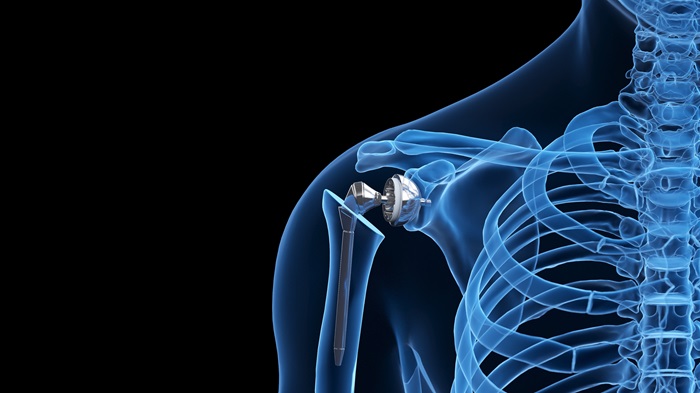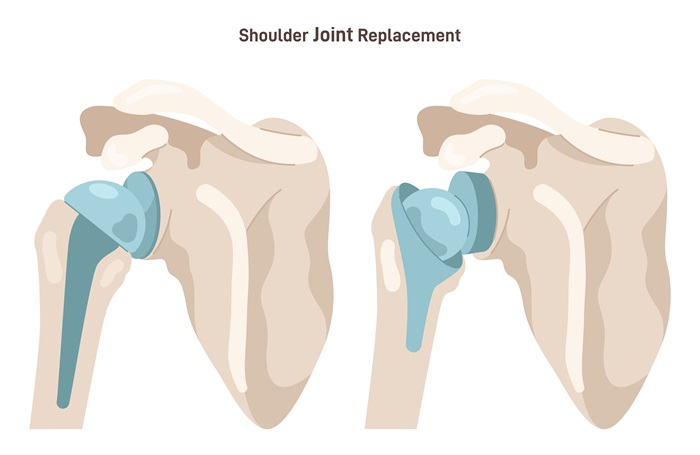Shoulder replacement surgery is a transformative procedure for individuals suffering from severe shoulder joint pain and dysfunction. This surgery involves replacing damaged shoulder joints and cartilage parts with artificial components to relieve pain and restore mobility.
In this guide, we’ll delve into the details of shoulder replacement surgery, including its types, diagnosis, procedure, risks, and recovery process.
Shoulder replacement, or shoulder arthroplasty, is a surgical procedure that helps relieve pain and improve function in the shoulder joint. This is achieved by replacing the damaged areas of the shoulder joint with artificial implants (prostheses). The doctors typically recommend surgery for patients with severe arthritis, rotator cuff tear arthropathy, or those who have sustained significant shoulder injuries.

It is done to ease pain and other issues caused by a damaged shoulder joint.
Wear-and-tear arthritis or osteoarthritis
Injuries to the rotator cuff or the muscles and tendons around the shoulder
Broken bones
Immune system-related joint inflammation
Loss of blood supply to the bone or osteonecrosis
Diagnosing the need for shoulder replacement involves a thorough evaluation by a shoulder replacement surgeon:
Your surgeon or a physical therapist will explain how to use the sling to keep your shoulder immobilised and how to perform physical therapy exercises.

Three Main Types of Shoulder Replacement are as follows:
This procedure involves replacing the bearing surfaces of the shoulder joint to an artificial ball and socket.
This is ideal in a shoulder where the rotator cuff is intact and functioning
Here the surgeon reverses the position of the ball and socket of the shoulder joint. The artificial socket is inserted in the place of the ball and the artificial ball is put in place of the socket.
This is indicated when there is a dysfunctional rotator cuff which affects the biomechanics of the shoulder joint.
The procedure involves replacing only the “ball” part of the joint and keeping the natural socket in place. This procedure is indicated in fractures of the ball part of the shoulder joint which are not amenable to fixation.
The shoulder replacement procedure typically involves the following steps:
Implantation of Prosthetic Components: The artificial components, made of high molecular weight polythene and titanium alloy, are implanted to replace the damaged joint surfaces.
While shoulder replacement surgery is generally safe, it carries some risks, including:
Recovery from shoulder replacement surgery involves several stages:
Shoulder replacement surgical procedures are highly effective for relieving shoulder pain and restoring function in patients with severe shoulder joint damage. With recent advancements in surgical techniques and prosthetic materials, most patients experience significant improvements in their quality of life. Understanding the procedure, risks, and recovery process can help individuals make conscious decisions about their treatment options.
Yes, shoulder replacement is considered a major surgery. It involves removing the damaged and diseased joint and replacing it with artificial components, requiring significant recovery and rehabilitation.
Shoulder replacement recovery time varies greatly and typically depends on the type of shoulder replacement and the severity of the ailment. However, most patients can resume daily activities within 3 to 6 months. Full recovery and return to all activities may take up to a year.
Pain levels vary among patients, but most experience significant pain relief after the initial postoperative period. Pain management modalities, such as medications and physical therapy, are essential for recovery.
While patients can resume most activities, doctors generally advise patients to avoid high-impact sports or activities that put undue stress on their shoulder joints to prevent damage to the implant.
Categories: Orthopedics
Shoulder Replacement: Surgery & Recovery is available for appointments. Please fill the below form to book an appointment.
Unlock the door to exceptional healthcare, book an appointment with SPARSH Hospital and let your journey to wellness begin.